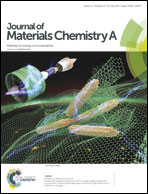Three-dimensional graphene oxide/polypyrrole composite electrodes fabricated by one-step electrodeposition for high performance supercapacitors†
Abstract
Three-dimensional (3D) graphene oxide/polypyrrole (GO/PPy) composite electrodes have been fabricated via one-step electrochemical co-deposition in an aqueous solution containing pyrrole monomers, GO and LiClO4. The concentration of GO in the solution plays an important role in controlling the morphologies of the as-deposited GO/PPy composites, and a relatively low concentration of 0.1 mg mL−1 is favorable for the formation of a 3D interconnected structure. The unique 3D interconnected structure ensures fast diffusion of electrolyte ions through the electrode. As a result, the GO/PPy composite electrode with a mass loading of 0.26 mg cm−2 exhibits the highest specific capacitance of 481.1 F g−1, while the electrode with a larger mass loading of 1.02 mg cm−2 delivers the best area capacitance of 387.6 mF cm−2, at a current density of 0.2 mA cm−2. Moreover, the GO/PPy composite electrodes exhibit good rate capability with capacitance retentions over 80% when the current density load increases from 0.2 to 10 mA cm−2. Both the aqueous and solid-state supercapacitors based on GO/PPy composite electrodes show excellent capacitive properties with good cycling stability, indicating their suitability for applications in energy storage and management.


 Please wait while we load your content...
Please wait while we load your content...